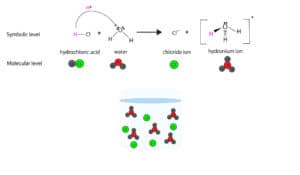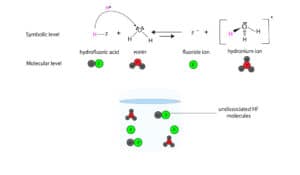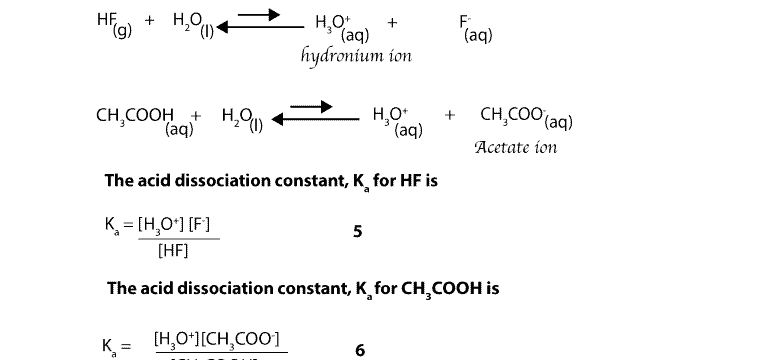Hydrochloric acid (H-Cl), nitric acid (H-NO3), and sulfuric acid(H-HSO4) are strong acids because they fully dissociate in water to produce hydronium ions. While hydrofluoric acid(H-F) and acetic acid(CH3COO-H) are weak acids because they partly dissociate in water to produce hydronium ions. Because strong acids fully dissociate in water, they produce lots of hydronium ions in solution, making the solution more acidic. While weak acids produce fewer hydronium ions, making the solution less acidic. Why do weak acids dissociate less while strong acids dissociate more? They do because of differences in:
- polarity—more polarized, more likely to dissociate a lot
- bond strength—stronger bond, less likely to dissociate a lot
- stability of conjugate base—more stable, more likely to dissociate a lot
If we write an equilibrium equation for each of the strong acids, here is how each will appear.

From the equilibrium equations, you can see that only a single arrow points to the right. This convey the message that the strong acids fully dissociate in water and that the equilibrium for the dissociation lies largely to the right.
Thus, the more hydronium ions you have in solution, the larger the acid dissociation constant (Ka) and the stronger the acid. The equilibrium constant, Ka is derived when we multiply the equilibrium constant, Kc by the concentration of water. But the concentration of water is so large that it’s relatively constant for dilute solutions.
Here is a molecular level diagram showing the complete dissociation of HCl in water.

If we write equilibrium equations for the weak acids, here is how each will appear:

As you can see, a shorter arrow points to the right, meaning only few HF molecules dissociate to produce hydronium and fluoride ions. However, these ions easily combine to get back HF and water molecules. As a result, the equilibrium lies largely to the left, which is why we drew the reverse arrow longer than the forward arrow.
Here is a molecular level diagram showing the incomplete dissociation of HF in water.

To learn more about the general properties of acids, click here.
